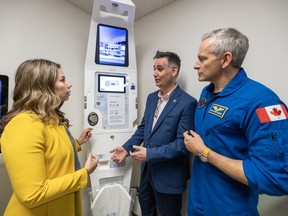Based on technology developed for the Canadian Space Agency, a new pilot project is intended to help identify medical conditions that need attention among people on the wait list for a GP.

A Montreal health authority is hoping that technology developed to help astronauts monitor their health in space will help it improve care for people who are on the waiting list for a family doctor.
“This is a way for us to basically cut into the curve and give an access point and insight to patients who in appearance could be healthy, but may not be,” he said in an interview.
The system — based on technology developed for the Canadian Space Agency by Edmonton-based company Baüne, which has adapted its platform for a clinical setting on Earth — uses a kiosk that can take a number of vital signs from a patient, as well as ask health screening questions, like whether a patient smokes.
That data is then fed into a dashboard that can be monitored by a nurse or other health-care professional in real time, and the system can also alert a professional to potential health concerns.
The data becomes part of the patient’s digital health record and, over time, the system’s artificial intelligence can flag changes that might indicate underlying health problems.
Gabay said he wants to give healthy people reassurance, while ensuring those who are at risk can see a doctor more quickly. If the system works, he hopes patients without a family doctor would be able to use it for a screening every six months.
“The objective really is to be able to give access to routine reviews through different health-care workers, to ensure that patients aren’t caught in a gap and are able to have their health status monitored, with front-line intervention from a preventive health-care perspective,” he said.
The pilot project will start with a single kiosk at the CLSC de Pierrefonds. Nurses will be available to see patients whose screenings show potential issues, and doctors working in the Lakeshore General Hospital’s family medicine group will see patients who need further care or assessment.
If the pilot project is successful, more kiosks could be deployed, including in places where a nurse isn’t on site, such as pharmacies, Gabay said.

It’s not the first time technology developed for space has been adapted for use on Earth, he said.
“Because going to space is so difficult and the requirements are so extreme, it is a great spark for innovation,” Saint-Jacques said. “We end up scratching our heads a bit harder than we would otherwise, and then, lo and behold, once we have figured things out for the excuse of space, then we have them on Earth. The whole of modern computing was basically developed for the Apollo program, for the excuse of going to the moon.”
Andrea Galindo, the CEO and co-founder of Baüne, said what distinguishes her company’s system from others is that it brings all the health data it gathers together in a single platform.
“It’s not necessarily about one medical device, but rather the connectivity of multiple devices, reducing the silos that exist in the health-care system,” she said.
As an engineer, she said, designing for space was something she dreamed about, but now she’s most proud of the fact that her technology could have an impact for everyday people.